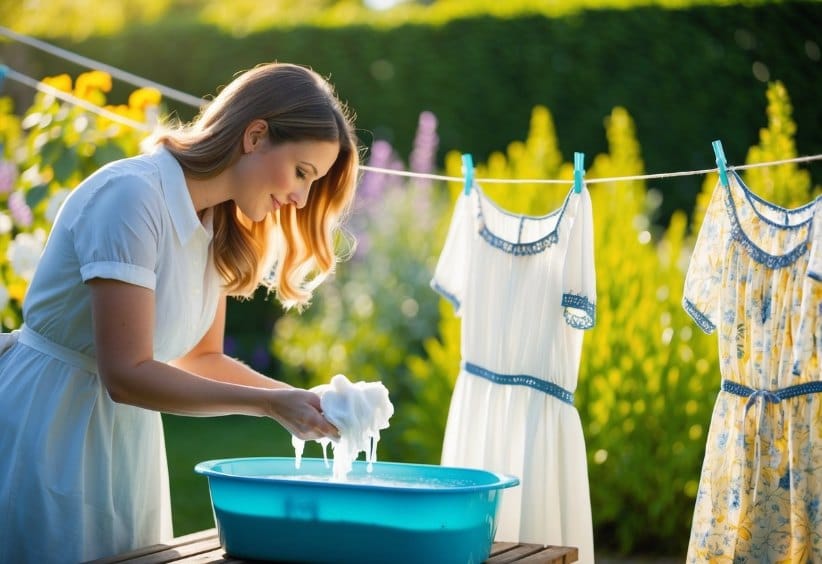Taking care of women’s dresses doesn’t have to be complicated. With a few simple steps, you can keep your favorite frocks looking fresh and fabulous for years to come. Proper care starts with reading the label and following its instructions for washing, drying, and storage.
I always separate my dresses by color and fabric type before washing. For delicate items, I use cold water and a gentle cycle. Sturdier fabrics can handle warm water. A mild detergent works best for most dresses. After washing, I reshape dresses if needed and hang them to air dry or use the dryer on a low heat setting.
Storing dresses correctly is just as important as washing them. I use padded hangers to prevent shoulder bumps and keep dresses wrinkle-free. For special occasion dresses, garment bags offer extra protection. Treating stains quickly and spot-cleaning when possible helps maintain the dress’s appearance between washes.
Table of Contents
Key Takeaways
- Read care labels and follow instructions for washing and drying
- Use gentle cycles, mild detergents, and appropriate water temperatures
- Store dresses on padded hangers and treat stains promptly
Understanding Women’s Dress Materials

Women’s dresses come in many different fabrics. Each material has its own unique qualities and care needs. Knowing the fabric type helps me take better care of my dresses.
Identifying Fabric Types
I always check the label to see what a dress is made of. Cotton dresses feel soft and breathable. They’re easy to wash at home. Silk dresses have a smooth, luxurious feel. They need gentle care and often require dry cleaning.
Polyester is durable and wrinkle-resistant. I can usually machine wash polyester dresses on a gentle cycle. Rayon drapes nicely but can shrink if not washed carefully. For rayon, I use cold water and lay flat to dry.
Delicate fabrics like lace or chiffon need extra care. I hand wash these or take them to a professional cleaner. Some common dress fabrics:
- Cotton: Breathable, easy to wash
- Silk: Luxurious, requires gentle care
- Polyester: Durable, wrinkle-resistant
- Rayon: Drapes well, can shrink if not careful
- Delicate fabrics: Need special handling
Knowing the fabric helps me keep my dresses looking great for longer.
Reading and Interpreting Care Labels

Care labels give vital info on how to clean and maintain women’s dresses. They use symbols and text to explain proper washing, drying, and ironing methods. Learning to read these labels helps keep dresses in great shape for longer.
Care Label Symbols
Care labels use small pictures to show how to clean clothes. The washtub symbol tells me about washing. A square means drying tips. A triangle gives info on bleach use. An iron shape covers ironing needs. A circle refers to dry cleaning.
I see numbers in the washtub that tell me the best water temp. Dots in the iron show heat levels for pressing. Lines under symbols mean gentler care is needed. An X through any symbol warns me not to use that method.
I always check for extra text on labels too. It may give more details on cleaning or warn about things like shrinkage.
Deciphering Washing Instructions
When I wash dresses, I look at the care label first. The washtub symbol guides me. If it has an X, I know not to machine wash. One line under means to use the gentle cycle. Two lines tell me to use the delicate setting.
I check the number in the tub for water temp. 30 means warm, while 40 is hot. Hand wash symbols look like a hand in water. Some labels say “Dry Clean Only” – I take those to a pro.
I also see notes about using mild soap or washing similar colors together. Following these tips keeps my dresses looking great wash after wash.
Effective Washing Techniques

Proper washing is key to keeping women’s dresses looking their best. I’ll cover both hand washing for delicates and using the washing machine for sturdier garments.
Hand Washing Delicates
I always hand wash delicate dresses in cold water with a mild detergent. I fill a clean sink or basin and gently swish the dress, paying extra attention to any stained areas.
I never wring or twist the fabric. Instead, I press out excess water and roll the dress in a clean towel. This helps remove moisture without damaging the fabric.
For dresses with beading or sequins, I use extra care. I wash them separately and avoid rubbing embellished areas. A mesh laundry bag can provide added protection.
Using the Washing Machine
For machine-washable dresses, I use the delicate cycle and cold water. I add a small amount of gentle laundry detergent.
I turn dresses inside out before washing to protect the outer fabric. For extra protection, I place them in a mesh laundry bag.
I avoid overloading the machine. This allows dresses to move freely and get clean without excessive wrinkling.
For cotton or linen dresses, I may use warm water if they’re very dirty. But I always check the care label first to be sure.
After washing, I remove dresses promptly to prevent wrinkles. I reshape them gently if needed before hanging to dry.
Proper Drying and Wrinkle Prevention

Drying and preventing wrinkles are key steps in caring for women’s dresses. I’ll cover the best methods for drying different types of dresses and share tips to keep them wrinkle-free.
Air Drying Versus Tumble Drying
Air drying is often the safest choice for delicate dresses. I hang dresses on padded hangers or lay them flat on a drying rack. This keeps the fabric’s shape and prevents stretching. For cotton or linen dresses, I use wooden hangers to avoid marks.
I avoid direct sunlight, which can fade colors. Instead, I pick a shaded, breezy spot indoors. Tumble drying works for some sturdy fabrics like cotton. I use a low heat setting and take dresses out while slightly damp to reduce wrinkles.
For delicate items, I never use the dryer. The heat and tumbling can damage beads, sequins, or delicate trims. I always check the care label before deciding how to dry a dress.
Ironing and Steaming
Ironing and steaming are great ways to remove wrinkles from dresses. I always check the care label first to make sure the fabric can handle heat. For delicate fabrics, I use a steamer. It’s gentle and won’t damage the dress.
When ironing, I set the right temperature for the fabric. I use a pressing cloth to protect delicate areas. For stubborn wrinkles, I spray a bit of water before ironing. This helps smooth out the fabric.
To prevent wrinkles, I hang dresses right after washing. I use padded hangers for knits and wooden ones for woven fabrics. For travel, I roll dresses instead of folding them. This takes up less space and reduces creases.
Stain Treating and Maintenance

Keeping women’s dresses clean and well-maintained is key to making them last. I’ll share some tips for tackling stains quickly and caring for dresses long-term.
Immediate Stain Treatment
When I spot a stain on a dress, I act fast. I blot the stain gently with a clean cloth to soak up excess liquid. I avoid rubbing, which can spread the stain. For oil-based stains, I sprinkle baking soda to absorb the oil before washing.
I use stain removers made for specific fabrics. On cotton, I apply a paste of baking soda and water. For delicates, I dab with mild soap. I always test stain treatments on a hidden area first.
Some tough stains need special care. For red wine, I pour salt on the spot to soak it up. With ink stains, I dab rubbing alcohol carefully. Grass stains often come out with a mix of vinegar and water.
Long-Term Garment Care
I wash dresses according to their care labels. Delicate fabrics go in mesh bags on gentle cycles. I use cold water for most items to prevent fading and shrinking. For stubborn odors, I add 1/2 cup of white vinegar to the rinse cycle.
I avoid using bleach on colored dresses. Instead, I soak them in oxygen-based bleach to brighten colors safely. For white dresses, I use a small amount of chlorine bleach when needed.
I always air-dry delicate dresses flat or on padded hangers. This helps keep their shape. I store dresses in a cool, dry place away from direct sunlight. I use breathable garment bags for long-term storage to prevent dust and yellowing.
Storage and Preservation of Dresses

Proper storage and care are key to keeping dresses in great shape. I’ll share some tips on organizing your wardrobe and protecting dresses from damage.
Wardrobe Organization
I always start with good hangers. Padded or wooden hangers work best for most dresses. They help keep the shape and prevent stretching.
For delicate dresses, I use garment bags. They shield against dust and light.
I group dresses by type – casual, midi, and maxi together. This makes picking outfits easier.
Folding is an option for some dresses. I lay them flat with tissue paper between folds.
I leave space between hangers. This stops dresses from getting squished or wrinkled.
Protecting Dresses from Damage
Moisture is a big threat to dresses. I make sure they’re fully dry before storage.
I avoid storing dresses in plastic bags. They can trap moisture and cause mildew.
For long-term storage, I use breathable garment bags or boxes.
I keep dresses away from direct sunlight. This prevents fading.
Static cling can be a pain. I use a light spray of water or fabric softener to stop it.
For cotton dresses, I fold them neatly. This avoids stretching from hangers.
I check stored dresses now and then. This catches any issues early.

